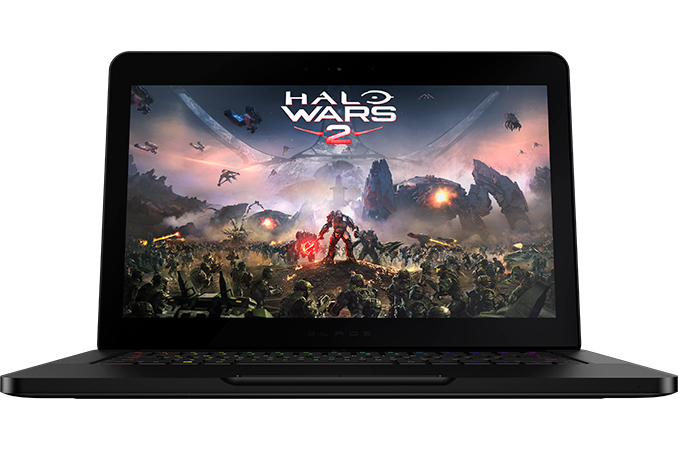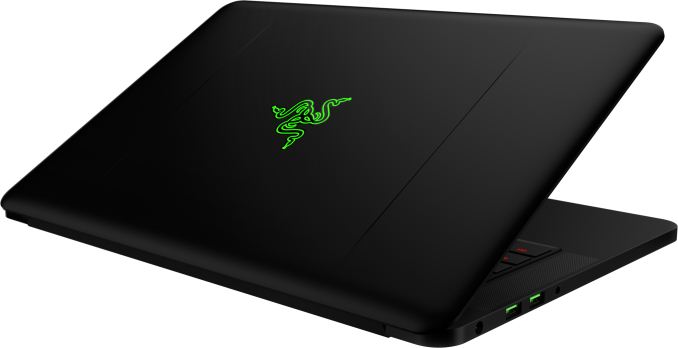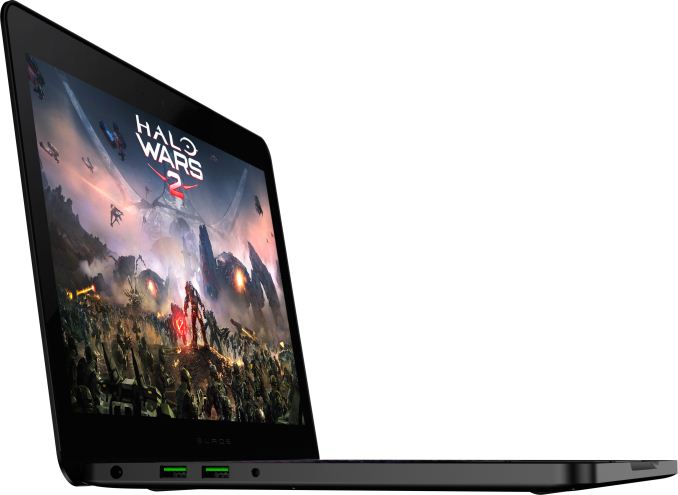Razer Blade Gets Core i7-7700HQ, Adds 4K Touchscreen, 1 TB SSD Options
by Anton Shilov on February 14, 2017 12:00 PM EST
Razer this week introduced an upgraded version of its latest Blade laptop that is now powered by Intel’s quad-core Kaby Lake processor along with DDR4-2400 memory and has 4K display and 1 TB SSD options. The 14” gaming notebook uses the same 17.8 mm-thick chassis introduced last year and has the same I/O capabilities, but some minor differences in weight. Meanwhile, it is important to note that the entry-level Razer Blade now costs $100 less than it used to last year, but at the expense of a lower-resolution display.
The new Razer Blade is based on the Intel Core i7-7700HQ (4C/8T, 2.8/3.8 GHz, 6 MB, 45 W) processor as well as the HM175 PCH (so, the same motherboard as before). The new chip is powered by the Kaby Lake microarchitecture, has higher frequencies compared to its predecessor that was used in last year’s Blades (Core i7-6700HQ) and supports Speed Shift v2 technology as well as other improvements. Along with the Kaby Lake CPU, the new Blade also got 16 GB of faster DDR4-2400 memory (soldered to the mainboard). In addition to 256 GB and 512 GB M.2 (NVMe/PCIe) SSDs, Razer now also offers a 1 TB PCIe drive as an option. When it comes to graphics, the new Blade uses NVIDIA’s GeForce GTX 1060 with 6 GB of GDDR5 memory and an HDMI 2.0b output, just like the predecessor introduced last fall.
Apart from the CPU and DRAM upgrades, Razer changed display options for the latest breed of Blade laptops. Last year the company only offered its Blades with touch-enabled IGZO LCDs featuring 3200×1800 resolution, and a matte 1920x1080 on the entry level. This year the higher-end Blade machines will feature touch-enabled UHD displays (3840×2160). Usage of the lower-resolution panel allowed Razer to reduce the price of the entry-level Blade to $1899 (or by $100), but at present we do not know how much the 4K SKUs is going to cost. In any case, systems featuring FHD panels will be slightly lighter and will have a longer battery life than models with UHD monitors. We haven't heard back from Razer on if the new UHD display continues to be a Sharp IGZO panel or not. Apart from displays, different Blade systems will look and feel exactly the same: both use a solid CNC-milled aluminum chassis with a matte black finish.
| Razer Blade Comparison | ||||||
| 2017 Razer Blade FHD | 2017 Razer Blade UHD | Late 2016 Razer Blade | ||||
| CPU | Intel Core i7-7700HQ 4C/8T 2.8 GHz/3.8 GHz 6 MB 45 W |
Intel Core i7-6700HQ 4C/8T 2.6/3.5 GHz 6 MB 47W |
||||
| GPU | NVIDIA GTX 1060 6 GB | |||||
| Memory | 16 GB DDR4-2400 | 16 GB DDR4-2133 | ||||
| Display | 1920×1080 matte | 3840×2160 touch | 3200×1800 IGZO touch | |||
| Storage | 256/512/1024 GB PCIe M.2 | 256/512 GB PCIe M.2 | ||||
| I/O | 3×USB 3.0 HDMI 2.0b Thunderbolt 3/USB-C |
|||||
| Wireless | Killer Wireless-AC 1535 | |||||
| Dimensions | 13.6" × 9.3 " × 0.70" 345 mm × 235 mm × 17.8 mm |
|||||
| Weight | 1.86 kg 4.1 lbs |
1.95 kg 4.3 lbs |
1.93 kg 4.25 lbs |
|||
| Battery | 70 Wh | |||||
| Keyboard | Razer Chroma anti-ghosting | |||||
| Price | $1899 | unknown | $1999-$2199 | |||
As for the rest I/O capabilities, they remained very similar to those of the last year’s Razer Blade models (because the chassis and the motherboard are the same as those used on the late 2016 Blade): Rivet Networks' Killer 1535 802.11 2×2 Wi-Fi + BT 4.1 controller, one Thunderbolt 3/USB 3.1 Type-C port, three USB 3.0 headers, an HDMI 2.0b output, a 2 MP webcam, built-in speakers and a microphone, a TRRS audio connector, a keyboard with RGB backlighting and so on. In a bid to appeal to those who care about security, there is a TPM 2.0 security chip installed.
The new Razer Blade notebooks with FHD screens are available now in North America and Europe starting from US$1,899/C$2,749/€2.149/£1.799. The laptops with 4K UHD panels will be available in Q2 and Razer does not have pricing available at the moment, but expect it to be similarly priced to the outgoing QHD+ model.
Related Reading:
Source: Razer


















47 Comments
View All Comments
Diji1 - Saturday, February 25, 2017 - link
" I'm glad we can both agree that it's pretty silly"Yes, it was pretty silly when you jumped in and commented on the thing your claiming is silly.
vincentlaw - Wednesday, February 15, 2017 - link
Actually, no, you're wrong.1. 1080 is high-end.
2. 1070 is mid-high.
3. 1060 is mid.
4. 1050 Ti is mid-low
5. 1050 is low.
6. 1040 (whenever it's released) is budget.
Diji1 - Saturday, February 25, 2017 - link
Really it's rather arbitary whether you claim the 1060 is mid range or low range so it's an argument not worth having :).I think we can all agree though that if you want to run modern games you won't be running them at 4K which makes it rather pointless.
TEAMSWITCHER - Tuesday, February 14, 2017 - link
When Apple introduced the marketing term "Retina Display" they backed it up with a metric that calculates resolution as a function of the viewing distance. PPD (Pixels Per Degree) is the number of pixels that you see in one degree of the viewing angle from the designed viewing distance. Apple engineers found that at 57 PPD was the limit that the human eye can perceive (My eyes are worse actually). Given an 18" viewing distance for a laptop the angular resolution the 14" 4K display is 98.87 PPD...That is overkill. The other FHD screen option (1920 x 1080) is only 49.43 PPD which isn't quite a retina display. Seems that Razor should have gone with something in between these two extremes...ciparis - Wednesday, February 15, 2017 - link
I would love to see a 1440P option.vincentlaw - Wednesday, February 15, 2017 - link
Apple's metrics are actually just hand-waving. Want proof? Draw 2 parallel 1 pixel lines separated by 1 pixel of space. Can you discern the two lines on a Retina display? Yes? Then you can still discern individual pixels and there is room to improve. We're going to need to more than triple the resolution to really meet the actual limits of human vision.Diji1 - Saturday, February 25, 2017 - link
I agree.I used to think 5.5" 4K smartphones were ridiculous and pointless however now after owning one there is something to be said for increased image quality at this res and size.
It's not something I think is necessarily worth much but if you can have it there is a difference in quality.
That said if I wanted a laptop for gaming only then this laptop having 4K is a bad choice because you can't use that res for gaming with the vidya card.
halcyon - Tuesday, February 14, 2017 - link
4K 14" touch screens are an exercise in studpidity. Esp. on a gaming laptop. Yeah, if you want a free mirror, it now comes with greasy fingerprint smudges.Flunk - Tuesday, February 14, 2017 - link
I agree with you, I have a 15" 4K touchscreen laptop and I never, ever use the touchscreen. But I had to buy it anyway because there was no 4K non-touchscreen option.Diji1 - Saturday, February 25, 2017 - link
Absolutely for gaming, it's ridiculous.But then again some Razer fans do seem to like big numbers etc.